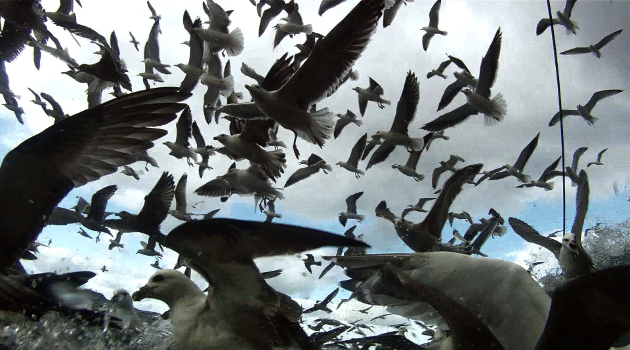Written and directed by Peter Berg
USA, 2013
The most unsettling moment in Lone Survivor, upon reflection, is its opening shot, one that mirrors the first moments of the extended long-take beginning of Gravity, albeit in a more Earthbound fashion. The former is a static shot of bleak, dry land in Afghanistan as a helicopter flies toward the camera, evoking something akin to the head of a prowling carnivore in the jungle, calmly stalking its prey. Initially, it’s not entirely clear what the faraway black spot growing ever closer is. Eventually, the copter looms large in the shot, just as the Space Shuttle ends up engulfing the eyeline in Gravity after an endless minute wherein sounds echo in tinny fashion in the distance, minute specks becoming clearer and drifting into full focus.
Lone Survivor and Gravity share, on the most basic level, more similarities than just how they start. Like All is Lost and Captain Phillips, these new films traffic in a basic theme of isolation. Opening (at least in Los Angeles and New York City) at the tail end of 2013, Lone Survivor isn’t so much the frontrunner of the pack as it is the simplest. As with Captain Phillips, this is based on a true story involving the U.S. Navy overseas. Like All is Lost, it opens in medias res (and as with All is Lost, that writing device serves no positive purpose and should’ve been jettisoned). And like all of these films, Lone Survivor positions a well-known star at the center of a story whose characters dwindle until there’s seemingly just one good guy left. This film works in broad strokes, so perhaps it’s more appropriate to call Mark Wahlberg’s lead character, Navy SEAL Marcus Luttrell, a Good Guy staving off a firefight from the Taliban.
From a storytelling perspective, writer/director Peter Berg doesn’t need much more to work with than the absolute basics. A group of SEALs, led by Mike Murphy (Taylor Kitsch), begin Operation Red Wings, an attempt to take down a high-level Taliban target in an Afghan village. Soon after the mission begins, Murphy, Luttrell, and the other SEALs (Ben Foster and Emile Hirsch) run into some goatherds and decide to stick to the rules of engagement, which effectively alerts the Taliban to their position. From that point, they try to shoot their way out against a larger enemy with more firepower. After the first third of this well-meaning, 2-hour faux-commercial for the Navy, the action begins properly and barely lets up. In the initial skirmish, Berg acquits his directorial chops nicely, in spite of the fact that each SEAL looks awfully similar to the others, one beard blending into the next. Or maybe he meant to unify the quartet into an army of one, effectively eliminating any potential for unique character development. Even before the guys get suited up for the mission, when we hear them bantering, it’s about the same thing: their wives and girlfriends, and just how crazy ladies are, or just how hilarious Anchorman was. The opening credits, set to a montage of real men training in the military, ends with the uttered phrase “band of brothers”; in the early scenes, this seems more like a band of bros.
Once the gunfights begin, Lone Survivor recalls nothing less than a hybrid between a Western shootout and a zombie movie. (Fitting, to the latter connection, that Greg Nicotero and Howard Berger went from working on the special, and especially gory, makeup effects for The Walking Dead to working on the same type of effects in this movie. In the second half, the blood flows like the Euphrates.) The four SEALs, bearded and in camouflage, have no singular identity, just a pack mentality; when they reach the throes of death, their breath becomes ragged and raspy. These men fold into each other, blending to an impossible degree. The same goes for the terrorists, who are given exactly zero character depth. We barely see them talking, only as faraway figures wielding impossible weaponry. In fact, Berg never offers much shading to anyone who’s not American; even the Afghan villagers, who may not all be as bloodthirsty as the Taliban leaders, are seen as an implacable Other. (This, even though the final quarter brings to mind Rio Bravo, as a group of people in a small town protect an outsider from a vicious posse.) Marcus knows only the language of being American, and so does this film.
Lone Survivor is exceptionally straightforward, in spite of the pointless in medias res opening that only removes any possible tension from the third act. Peter Berg’s entire filmography represents the spectrum of the straightforward, evidenced by the workmanlike efficiency in the crafting of films like Friday Night Lights, The Kingdom, and The Rundown. There may have been a time when his reliance on shaky-cam photography felt fresh and new; now, it is expected in almost every modern action movie, so when it’s used here, it has the ring of the familiar. Though his hand is surer in the first two-thirds, the action geography becomes muddled in the last act, as does the pacing. Lone Survivor—whose very title, frankly, spoils the story—is in a hurry to leave the Afghan village around which Marcus and his comrades defend themselves, possibly because it represents a level and layer of complexity this film is unable or simply unwilling to aim for.
— Josh Spiegel






